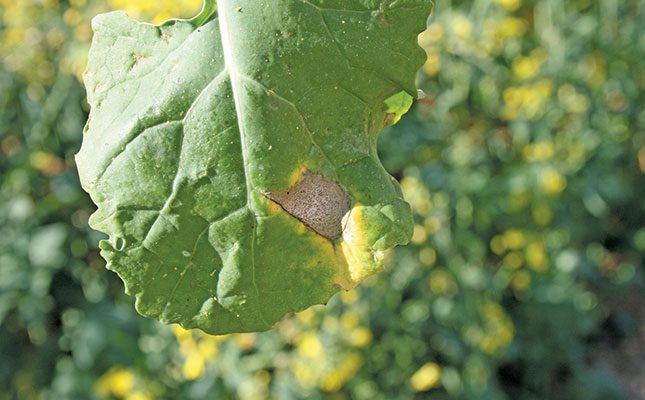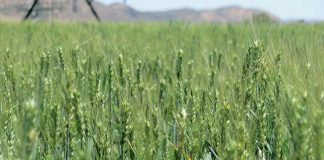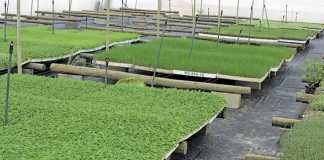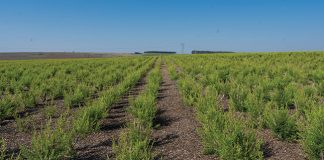
Photo: Supplied
While the extent of losses in South Africa is uncertain, canola farmers in Australia generally lose between 10% and 15% of their harvests annually to blackleg, with figures as high as 90% being recorded in some instances. This is according to Dr Gert van Coller, plant pathology scientist at the Western Cape Department of Agriculture and a speaker at a Knowledge Hub event presented by Syngenta and John Deere in Napier in the Western Cape in October last year. Global losses to the disease are estimated at over R16 billion annually.
FUNGAL SPECIES
Blackleg is caused by two fungal species, namely Leptosphaeria maculans and L. biglobosa. These can affect any part of the plant and result in leaf and pod lesions, and stem and crown canker.
L. maculans, the more virulent of the two, is by far the most common in South Africa. It causes crown canker, which has a major impact on yield by inhibiting nutrient and water transportation in plants, as well as stem canker and upper canopy infection.
L. biglobosa causes more superficial canker on the upper parts of the stem and is therefore less damaging.
To complicate matters, explains Van Coller, there are a number of races of L. maculans, and scientists are currently researching the occurrence of these in the Western Cape, where most of South Africa’s canola is planted.
Disease cycle
The blackleg pathogen survives on infected canola stubble left on the land after harvest. This produces fruiting bodies called pseudothecia, which are visible as small black dots on the stubble. These in turn release sexual spores, called ascospores, after the first autumn rains, with 2mm to 3mm of rain being enough to initiate the disease.
The ascospores are transmitted via air currents and infect the leaves of canola seedlings and older plants. Infected leaves have characteristic pale leaf spots, with small black dots called pycnidia.
In general, infection up to the five-leaf stage is responsible for crown canker later in the season, as the fungus grows from the leaf lesion down the petiole to the young stem, where it remains latent until flowering. The pathogen then becomes necrotic and causes the canker.
The fungus may also grow into the plant’s taproot, where it results in root rot. Ascospores released later in the season can infect older leaves, branches and seed pods to cause upper canopy infection.
Pycnidia on infected leaves carry asexual spores, called conidia, which are released during wet conditions. These are often scattered onto nearby plants and leaves by raindrops, a process called splash disperal.
How to fight infection
A few options are available to lower the risk of blackleg infection, but none is foolproof, according to Van Coller.
The first of these is crop rotation, where canola is not planted on the same land for at least four years. This helps to break the cycle and thereby significantly reduces disease risk.
Unfortunately, though, the crop can still become infected from stubble on adjacent lands.
The only way to prevent infection from this source is to plant canola more than 500m away from lands where canola was planted the previous year. But this, Van Coller points out, is impractical in most cases, as few farms are large enough, and farmers have no control over what their neighbours plant on their borders.
Other alternatives are chemical control and the use of blackleg-resistant varieties, which should be combined with crop rotation for the best results.
Identifying resistant cultivars
Van Coller explains that Australia has developed a rating system to indicate specific canola cultivars’ susceptibility to blackleg, with the ratings ranging from highly susceptible to resistant.
No cultivar is 100% resistant, however. Unfortunately, South African farmers cannot rely on the Australian resistance rating of a specific cultivar, as the races of pathogen in Australia and South Africa can differ. Indeed, the pathogen populations in different regions of the same country can differ. Variations in climate can also result in different cultivar responses.
To overcome this problem, the Western Cape Department of Agriculture last year launched a series of field trials to test the resistance of local canola cultivars. The trials, which will be conducted annually, were started on a commercial farm near Riversdale and at the Langgewens (near Malmesbury) and Tygerhoek (near Riviersonderend) research farms.
From the 2022 season onwards, trials will also be conducted on a commercial farm near Hopefield.
Unfortunately, Van Coller and his colleagues were unable to obtain any useful results from the Tygerhoek trial last season, as the land was flooded shortly after planting.
At Riversdale, the cultivars Clearfield 43Y92, 44Y94, 45Y93 and 45Y95, and Alpha TT were among the top performers, while Hyola 559 TT and Hyola 650 TT performed poorly.
The top performers at Langgewens were the same as at Riversdale (barring Alpha TT), as well as Diamond, Quartz, Hyola 350 TT and Hyola 650 TT. Poor performers included Alpha TT, Hyola 559 TT, Blazer and 44Y90.
“Although the results from the 2021 trials at Langgewens and Riversdale were quite similar, the differences highlight the need to identify cultivar resistance in different regions,” says Van Coller, adding that data from succeeding years will be needed to make solid conclusions.
Cultivars planted will also have to be rotated with varieties that have different resistance genes in order to prevent a build-up of pathogen races able to overcome resistance over time.
Chemical control
At the same locations, the Western Cape Department of Agriculture this year launched field trials to evaluate the efficacy of six fungicides at controlling blackeg. Of these, five are registered against the disease and one unregistered. Results will be available towards the end of the season.
Van Coller says the trials will be repeated next year to produce reliable results and that, in future, the researchers will also investigate the timing and optimisation of fungicide applications.
Email Gert van Coller at [email protected].













